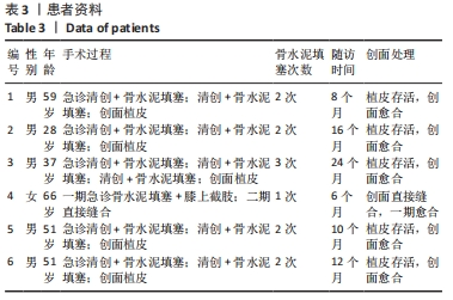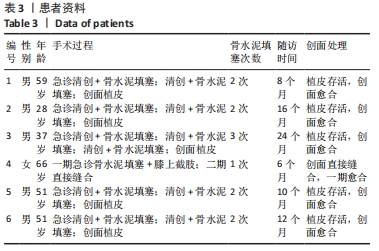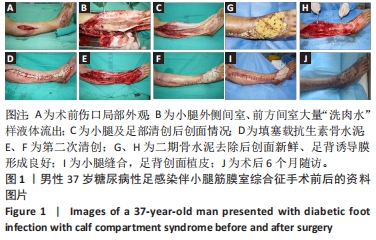[1] HODGINS N, DAMKAT-THOMAS L, SHAMSIAN N, et al. Analysis of the increasing prevalence of necrotizing fasciitis referrals to a regional plastic surgery unit: A retrospective case series. J Plast Reconstr Aesthet Surg. 2015;68(3):304-311.
[2] LEIBLEIN M, MARZI I, SANDER AL, et al. Necrotizing fasciitis: treatment concepts and clinical results. Eur J Trauma Emerg Surg. 2018;44(2):279-290.
[3] LEKHA A, ATHAR Y. Necrotising fasciitis: a fatal case of sepsis and a diagnostic challenge- case report and review of literature. Int J Emerg Med. 2018;11(1):23.
[4] KHARANUAN P, CHONGMKSUT W, JEARWATTANAKANOK K, et al. Necrotizing fasciitis:Risk factors of mortality. Risk Manag Healthc Policy. 2015;8:1-7.
[5] 林妙芝,李卫平,谢艺恺,等. 糖尿病足合并坏死性筋膜炎的风险评估[J].中华糖尿病杂志,2020,12(5):312-317.
[6] DAN M, AMI L, RAUL C, et al. Vibrio vulnificus necrotizing fasciitis of the calf presenting with compartment syndrome. Pediatr Infect Dis J. 2003;22(7):666-668.
[7] FILIPA CA, CARLOS N, LUÍS C, et al. Necrotizing Fasciitis Causing Acute Compartment Syndrome after Radial Artery Catheterization. Eur J Case Rep Intern Med. 2020;7(4):001525.
[8] JOSEPH M, KARIN L, ELLIS T, et al. Necrotizing Fasciitis. J Am Acad Orthop Surg. 2009; 17(3):174-182.
[9] JOHN WG, JUI KP, SHILPA MA, et al. Negative-pressure Wound Therapy for Periocular Necrotizing Fasciitis. Plast Reconstr Surg Glob Open. 2018;6(12):e1921.
[10] MRGAN MS. Diagnosis and management of necrotising fasciitis: a multiparametric approach. J Hosp Infect. 2010;75:249-257.
[11] 陆萌,李春睿,陈约东,等.糖尿病足手术: 治疗的一个关键组成部分[J].中华糖尿病杂志,2021,13(3):205-208.
[12] MUBARAK SJ, OWEN CA. Double incision fasciotomy of the leg for decompression in compartment syndrome. J Bone J Surg Am. 1977;59:184-187.
[13] STEVENS DL, BRYANT AE. Necrotizing soft-tissue infections. N Engl J Med. 2017;377(23): 2253-2265.
[14] TAN JH, KOH BT, HONG CC, et al. A comparison of necrotising fasciitis in diabetics and non diabetics: a review of 127 patients. Bone Joint J. 2016;98-B(11):1563-1568.
[15] JASON D, AIVEEN B, TIMOTHY P. Necrotising fasciitis. BMJ. 2020;369:m1428.
[16] GOH T, GOH LG, ANG CH, et al. Early diagnosis of necrotizing fasciitis. Br J Surg. 2014; 101(1):119-125.
[17] ZHANG ZD, LIU P, YANG BY, et al. Necrotizing fasciitis caused by diabetic foot. Int J Infect Dis. 2021;103:3-5.
[18] JUNHO A, KATHERINE MR, GEORGE TL, et al. Lower Extremity Necrotizing Fasciitis in Diabetic and Nondiabetic Patients: Mortality and Amputation. Int J Low Extrem Wounds. 2019;18(2):114-121.
[19] WONG CH, KHIN LW, HENG KS, et al. The LRINEC (Laboratory Risk Indicator for Necrotizing Fasciitis) score: a tool for distinguishing necrotizing fasciitis from other soft tissue infections. Crit Care Med. 2004;32(7):1535-1541.
[20] CARTER PS, BANWELL PE. Necrotizing fasciitis: A new management algorithm based on clinical classification. Int Wound J. 2004;1(3):189-198.
[21] LIPSKY BA, ARAGÓN-SÁNCHEZ J, DIGGLE M, et al. IWGDF guideline on diagnosis and management of foot infections in persons with diabetes. Diabetes Metab Res Rev. 2016; 32(1):45-74.
[22] JAVIER AS, BENJAMIN AL. Modern management of diabetic foot osteomyelitis. The when, how and why of conservative approaches. Expert Rev Anti Infect Ther. 2018;16(1):35-50.
[23] WAHL P, GUIDI M, BENNINGER E, et al. The levels of vancomycin in the blood and the wound after the local treatment of bone and soft-tissue infection with antibiotic-loaded calcium sulphate as carrier material. Bone Joint J. 2017;99-B(11):1537-1544.
[24] LIU C, YOU JX, LI HY, et al. Effect of Induced membrane formation followed by polymethacrylate implantation on diabetic foot ulcer healing when revascularization is not feasible. J Diabetes Res. 2019;2019:2429136.
[25] SAMUEL S, ELIZABETH K, CHRISTIAN V, et al. Predictors of Mortality and Limb Loss in necrotizing soft tissue infections. Am Surg. 2013;79(10):1102-1125.
[26] DANIEL AS, JOSE PT, EDUARDO PD, et al. Association of Negative Pressure Wound Therapy and Dermatotraction for Management of Necrotizing Soft Tissue Infections: A Case Series. Wounds. 2020; 32(8):217-220. |



